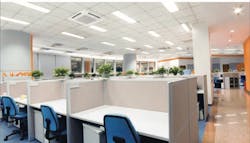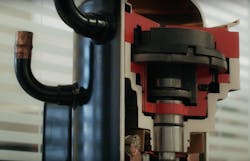VRF, DOAS and High-Performance Buildings
By KEVIN MISKEWICZ, director of commercial product planning, Mitsubishi Electric Trane HVAC US LLC
Today’s tech-savvy building owners – and occupants – are demanding more from their HVAC systems. Interest in more sophisticated ventilation systems is driven by some of the same trends that motivate the AEC community to adopt Variable Refrigerant Flow (VRF) technology for a more efficient, intelligent approach to cooling and heating.
An increased awareness of indoor environmental quality (IEQ) is one of several trends driving demand for better-performing ventilation systems. Building occupants have a greater awareness of the importance of IEQ and how it can be affected by climate and population density.
- Download the June 2018 white paper, DOAS and VRF: Applying Systems for High-Performance Buildings.
Energy efficiency is also more relevant than ever. Market-based incentives, a sustainability mindset and government regulation are leading building owners to look for energy-efficient HVAC solutions.
Additionally, more efficient and sophisticated cooling, heating and ventilation systems are needed as architects design high-performance buildings to satisfy the requirements associated with LEED, Green Globes, Passive House, zero-net energy, deep-energy retrofits and other sustainability programs. High-performance buildings also require tighter envelopes, making sophisticated mechanical ventilation even more critical for occupant well-being. Furthermore, regulatory requirements like AHRI Standard 920 are forcing efficiency into the ventilation market segment of HVAC.
Where does VRF come in?
VRF technology addresses many of these needs. Designed to provide energy-efficient comfort control for a building’s occupants according to the conditioning needs of a building’s zones, a VRF system moves conditioned refrigerant directly to each indoor unit instead of moving conditioned air through ductwork (or conditioned fluid through hydronic piping). The outdoor unit works in tandem with integrated controls and sensors that measure cooling and heating loads for each zone, and its compressor seamlessly adjusts speed to maintain the zone’s set point. VRF systems minimize the energy-intensive process of turning a compressor on and off to meet loads, which are subject to change throughout the day.
A complete, high-performance HVAC solution will also offer greater design flexibility. As a function of its sophisticated design, VRF systems are relatively compact, giving architects and building owners a range of installation options that maximize usable space within a building. Because the equipment is more compact than traditional HVAC systems, architects and building owners may design around an aesthetic vision without impacting the designs of engineers responsible for ensuring optimal performance of mechanical systems. Design freedom is also supported by whisper-quiet operation – VRF indoor units run at sound levels between 19 and 34 decibels, and outdoor units operate quieter than a typical conversation.
Finally, consumers are accustomed to interacting with smart technologies that provide near-instant access to information, and have developed expectations for personalized comfort control. Building occupants are looking for personalized control within their space, while building owners and facility managers want better centralized control of equipment through building management systems. These allow for more efficient management, greater insight and reporting and tighter control of utility costs.
VRF systems address this by using one (or more) outdoor units to support a network of zoned indoor units. Personalized comfort is achieved through individual controllers in each zone. Additionally, VRF units are more electronics-based than traditional HVAC systems, with built-in controls logic to support centralized and local control.
Complementing VRF with DOAS
Building owners and facility managers know what they need from HVAC systems, and a growing number are familiar with the benefits of VRF technology. It is important to understand how Dedicated Outdoor Air Systems (DOAS) complement VRF systems to meet building comfort demands and provide a complete, high-performance HVAC solution.
IEQ, for example, improves with the use of a DOAS. VRF systems are not purpose-built for ventilation, and as a system’s compressors run slower during partial load conditions, its coils handle less refrigerant and are less active. While this is great for energy efficiency, a warm evaporator coil in cooling mode does not dehumidify effectively. Consulting engineers who have adopted VRF for energy efficiency often also use a DOAS to handle ventilation and moisture removal.
At its most basic, mechanical ventilation introduces fresh, outside air into a space. While cooling and heating systems are regulated by energy codes concerned with efficiency and occupant comfort, ventilation systems are regulated under mechanical codes, which concern occupant safety. In the U.S., ventilation systems for commercial buildings must comply with state and local codes, based upon ASHRAE 62.1 or International Mechanical Code, which use similar calculations to determine a building’s ventilation requirements.
Digging deeper into DOAS
DOAS are dedicated ventilation systems designed to condition outdoor air. They are available as packaged equipment or as a split system to support decoupled designs. There are pros and cons to both options – packaged equipment is commonly more cost effective at startup and simpler to install, but split-system DOAS offers more design freedom inside and outside the building, allowing architects and building owners to separate and strategically arrange VRF outdoor units and DOAS equipment.
The use of DOAS also saves on the required cooling and heating tonnage, which manufacturers recognize is of growing importance to facility managers. In response to the growing demand for energy-efficient ventilation, some manufacturers, such as Mitsubishi Electric Trane HVAC, now offer split-system and packaged DOAS equipment with INVERTER-driven compressors like those found in VRF systems.
Room neutral conditions — the range of temperatures where humans experience comfort without needing to shiver to produce heat or sweat to cool off — can be more easily achieved using DOAS with INVERTER-driven compressors. Because reheat is typically only available on the lead refrigeration circuit, conventional DOAS produces room neutral air in a limited range of outside air operating conditions. With an INVERTER-driven design, there is only one refrigeration circuit regardless of tonnage. The result is a proportional amount of hot gas reheat to the cooling load, and the ability to deliver room neutral air to a wide range of conditions.
What can we expect for the future of ventilation?
Newly introduced efficiency metrics for ventilation will soon impact how equipment is manufactured. Ventilation is historically governed by mechanical codes, but AHRI Standard 920 introduced two new efficiency metrics for DOAS. Moisture Removal Efficiency (MRE) is a full load efficiency metric while Integrated Seasonal Moisture Removal Efficiency (ISMRE) is a part load efficiency metric. Think of these metrics as similar to Energy Efficiency Ratio (EER) and Integrated Energy Efficiency Ratio (IEER) for cooling. In the near future, architects, engineers and building owners will be able to find information at AHRIdirectory.org to compare products. The trend toward the regulation of efficiency is likely to drive more manufacturers toward including INVERTER-driven compressors in ventilation equipment. This is a great alternative to the option of increasing efficiency by making coils larger, which would take up more space and could become cost prohibitive and unattractive in terms of design.
The ability to assess and deliver the appropriate amount of ventilation in real time benefits occupant comfort, improves IEQ and saves energy. Motivated by new codes and standards, market-based incentives, a sustainability mindset and a global movement toward better building design, VRF manufacturers will continue to develop DOAS systems to meet building occupant needs. As adoption of VRF becomes more widespread, specialized ventilation systems are expected to become more widely recognized as a necessary component for comfort and a complete, high-performance HVAC solution.
Based in Atlanta, the author joined Mitsubishi Electric in 2014, and has led its U.S. marketing efforts for cooling and heating in the commercial segment since 2016.

